CIVL 0014 - Railway Engineering: Comparing Rail Networks in 3 Nations
VerifiedAdded on 2023/06/11
|17
|2030
|173
Report
AI Summary
This report provides a comparative analysis of railway networks and infrastructure in Singapore, the United Arab Emirates (UAE), and Egypt. It covers various aspects such as public transportation summaries, railway network maps and future plans, network lengths for passenger and freight corridors, city and urban track lengths, maximum annual traffic, track components, governed factors and critical parameters of track design, track design standards, salient features and landscapes of the railway networks, largest railway projects and existing plans, and railroad infrastructure organization charts. The report highlights the differences in railway systems, with Singapore focusing on high-speed and light rail, Egypt utilizing a regular railway system, and the UAE currently developing its railway network.
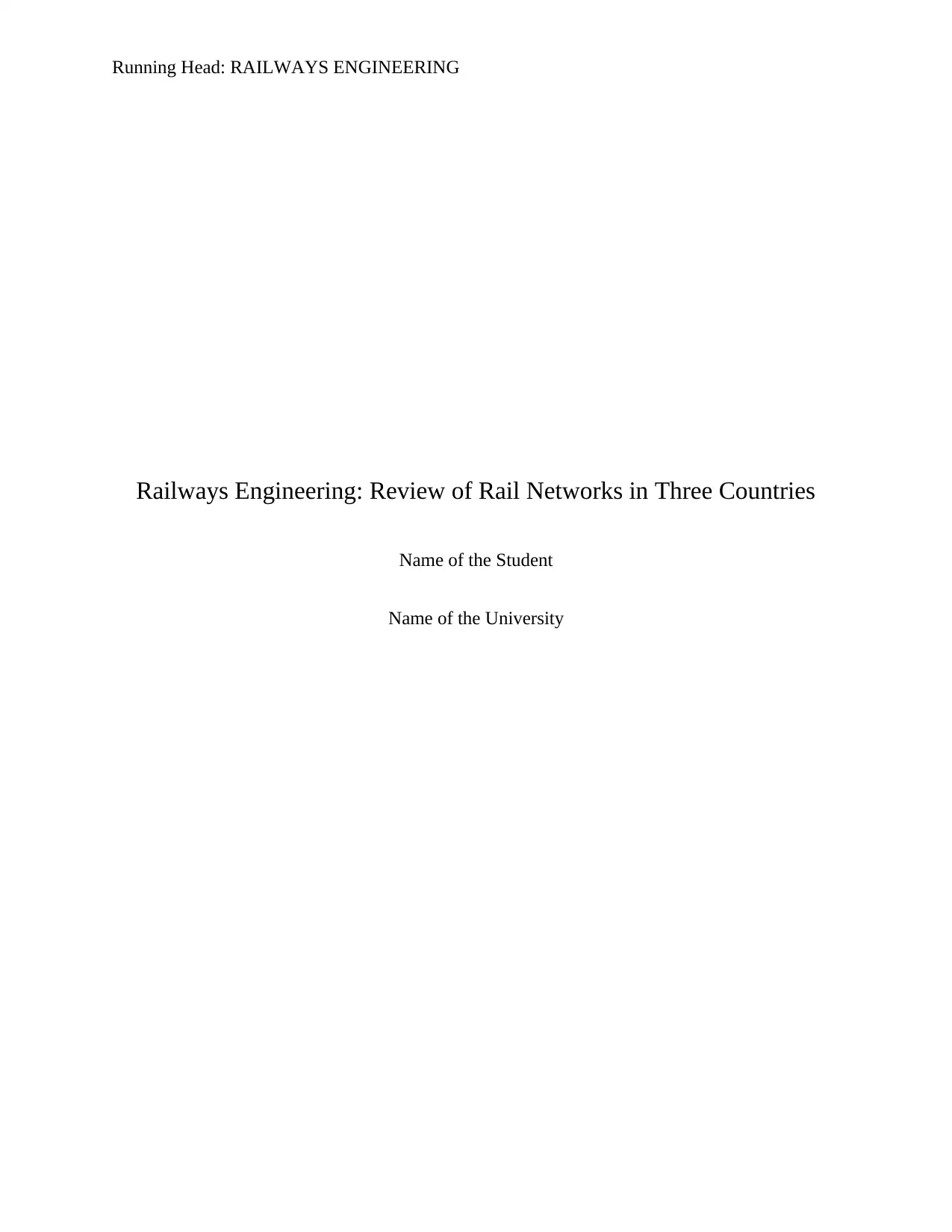
Running Head: RAILWAYS ENGINEERING
Railways Engineering: Review of Rail Networks in Three Countries
Name of the Student
Name of the University
Railways Engineering: Review of Rail Networks in Three Countries
Name of the Student
Name of the University
Paraphrase This Document
Need a fresh take? Get an instant paraphrase of this document with our AI Paraphraser
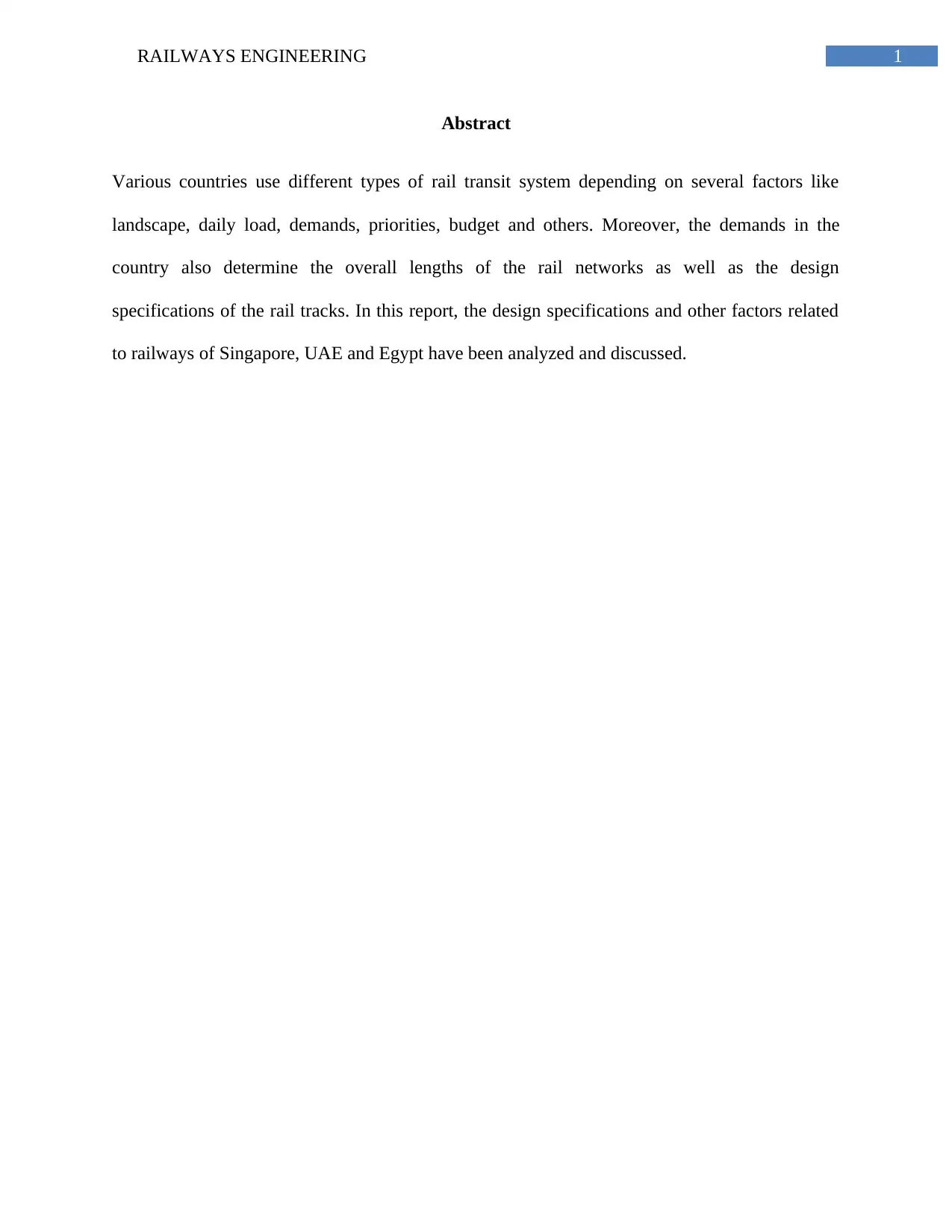
1RAILWAYS ENGINEERING
Abstract
Various countries use different types of rail transit system depending on several factors like
landscape, daily load, demands, priorities, budget and others. Moreover, the demands in the
country also determine the overall lengths of the rail networks as well as the design
specifications of the rail tracks. In this report, the design specifications and other factors related
to railways of Singapore, UAE and Egypt have been analyzed and discussed.
Abstract
Various countries use different types of rail transit system depending on several factors like
landscape, daily load, demands, priorities, budget and others. Moreover, the demands in the
country also determine the overall lengths of the rail networks as well as the design
specifications of the rail tracks. In this report, the design specifications and other factors related
to railways of Singapore, UAE and Egypt have been analyzed and discussed.
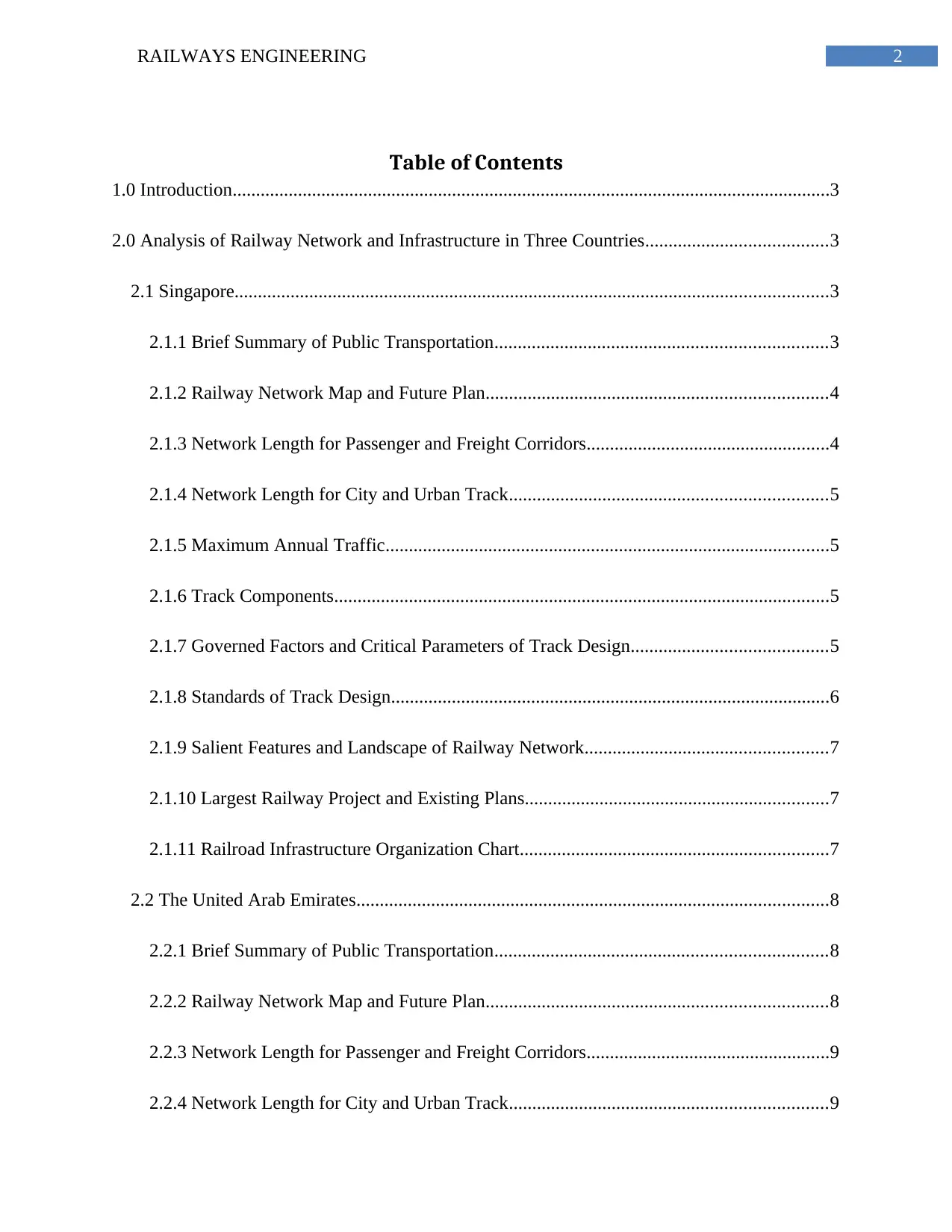
2RAILWAYS ENGINEERING
Table of Contents
1.0 Introduction................................................................................................................................3
2.0 Analysis of Railway Network and Infrastructure in Three Countries.......................................3
2.1 Singapore...............................................................................................................................3
2.1.1 Brief Summary of Public Transportation.......................................................................3
2.1.2 Railway Network Map and Future Plan.........................................................................4
2.1.3 Network Length for Passenger and Freight Corridors....................................................4
2.1.4 Network Length for City and Urban Track....................................................................5
2.1.5 Maximum Annual Traffic...............................................................................................5
2.1.6 Track Components..........................................................................................................5
2.1.7 Governed Factors and Critical Parameters of Track Design..........................................5
2.1.8 Standards of Track Design..............................................................................................6
2.1.9 Salient Features and Landscape of Railway Network....................................................7
2.1.10 Largest Railway Project and Existing Plans.................................................................7
2.1.11 Railroad Infrastructure Organization Chart..................................................................7
2.2 The United Arab Emirates.....................................................................................................8
2.2.1 Brief Summary of Public Transportation.......................................................................8
2.2.2 Railway Network Map and Future Plan.........................................................................8
2.2.3 Network Length for Passenger and Freight Corridors....................................................9
2.2.4 Network Length for City and Urban Track....................................................................9
Table of Contents
1.0 Introduction................................................................................................................................3
2.0 Analysis of Railway Network and Infrastructure in Three Countries.......................................3
2.1 Singapore...............................................................................................................................3
2.1.1 Brief Summary of Public Transportation.......................................................................3
2.1.2 Railway Network Map and Future Plan.........................................................................4
2.1.3 Network Length for Passenger and Freight Corridors....................................................4
2.1.4 Network Length for City and Urban Track....................................................................5
2.1.5 Maximum Annual Traffic...............................................................................................5
2.1.6 Track Components..........................................................................................................5
2.1.7 Governed Factors and Critical Parameters of Track Design..........................................5
2.1.8 Standards of Track Design..............................................................................................6
2.1.9 Salient Features and Landscape of Railway Network....................................................7
2.1.10 Largest Railway Project and Existing Plans.................................................................7
2.1.11 Railroad Infrastructure Organization Chart..................................................................7
2.2 The United Arab Emirates.....................................................................................................8
2.2.1 Brief Summary of Public Transportation.......................................................................8
2.2.2 Railway Network Map and Future Plan.........................................................................8
2.2.3 Network Length for Passenger and Freight Corridors....................................................9
2.2.4 Network Length for City and Urban Track....................................................................9
⊘ This is a preview!⊘
Do you want full access?
Subscribe today to unlock all pages.

Trusted by 1+ million students worldwide
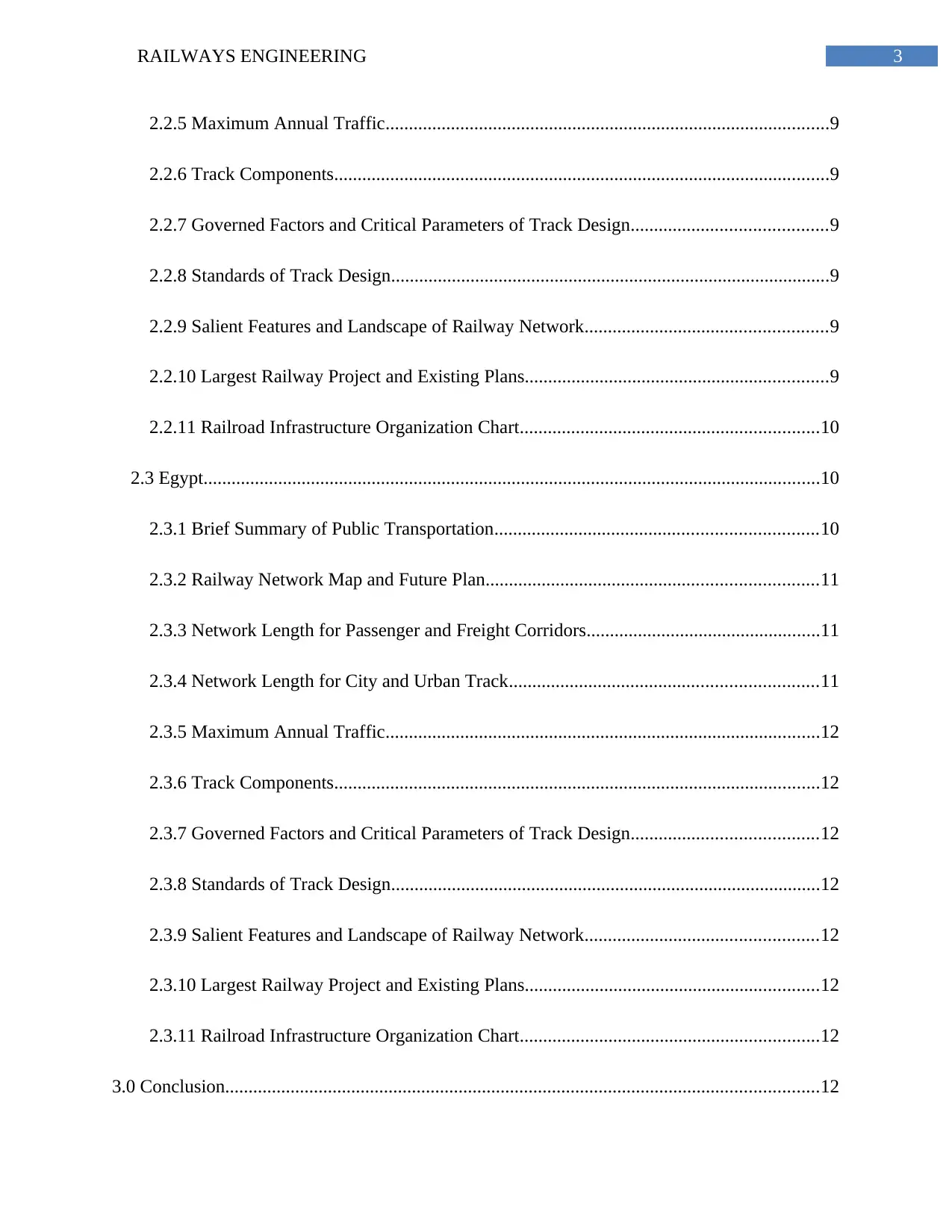
3RAILWAYS ENGINEERING
2.2.5 Maximum Annual Traffic...............................................................................................9
2.2.6 Track Components..........................................................................................................9
2.2.7 Governed Factors and Critical Parameters of Track Design..........................................9
2.2.8 Standards of Track Design..............................................................................................9
2.2.9 Salient Features and Landscape of Railway Network....................................................9
2.2.10 Largest Railway Project and Existing Plans.................................................................9
2.2.11 Railroad Infrastructure Organization Chart................................................................10
2.3 Egypt....................................................................................................................................10
2.3.1 Brief Summary of Public Transportation.....................................................................10
2.3.2 Railway Network Map and Future Plan.......................................................................11
2.3.3 Network Length for Passenger and Freight Corridors..................................................11
2.3.4 Network Length for City and Urban Track..................................................................11
2.3.5 Maximum Annual Traffic.............................................................................................12
2.3.6 Track Components........................................................................................................12
2.3.7 Governed Factors and Critical Parameters of Track Design........................................12
2.3.8 Standards of Track Design............................................................................................12
2.3.9 Salient Features and Landscape of Railway Network..................................................12
2.3.10 Largest Railway Project and Existing Plans...............................................................12
2.3.11 Railroad Infrastructure Organization Chart................................................................12
3.0 Conclusion...............................................................................................................................12
2.2.5 Maximum Annual Traffic...............................................................................................9
2.2.6 Track Components..........................................................................................................9
2.2.7 Governed Factors and Critical Parameters of Track Design..........................................9
2.2.8 Standards of Track Design..............................................................................................9
2.2.9 Salient Features and Landscape of Railway Network....................................................9
2.2.10 Largest Railway Project and Existing Plans.................................................................9
2.2.11 Railroad Infrastructure Organization Chart................................................................10
2.3 Egypt....................................................................................................................................10
2.3.1 Brief Summary of Public Transportation.....................................................................10
2.3.2 Railway Network Map and Future Plan.......................................................................11
2.3.3 Network Length for Passenger and Freight Corridors..................................................11
2.3.4 Network Length for City and Urban Track..................................................................11
2.3.5 Maximum Annual Traffic.............................................................................................12
2.3.6 Track Components........................................................................................................12
2.3.7 Governed Factors and Critical Parameters of Track Design........................................12
2.3.8 Standards of Track Design............................................................................................12
2.3.9 Salient Features and Landscape of Railway Network..................................................12
2.3.10 Largest Railway Project and Existing Plans...............................................................12
2.3.11 Railroad Infrastructure Organization Chart................................................................12
3.0 Conclusion...............................................................................................................................12
Paraphrase This Document
Need a fresh take? Get an instant paraphrase of this document with our AI Paraphraser

4RAILWAYS ENGINEERING
References......................................................................................................................................13
References......................................................................................................................................13
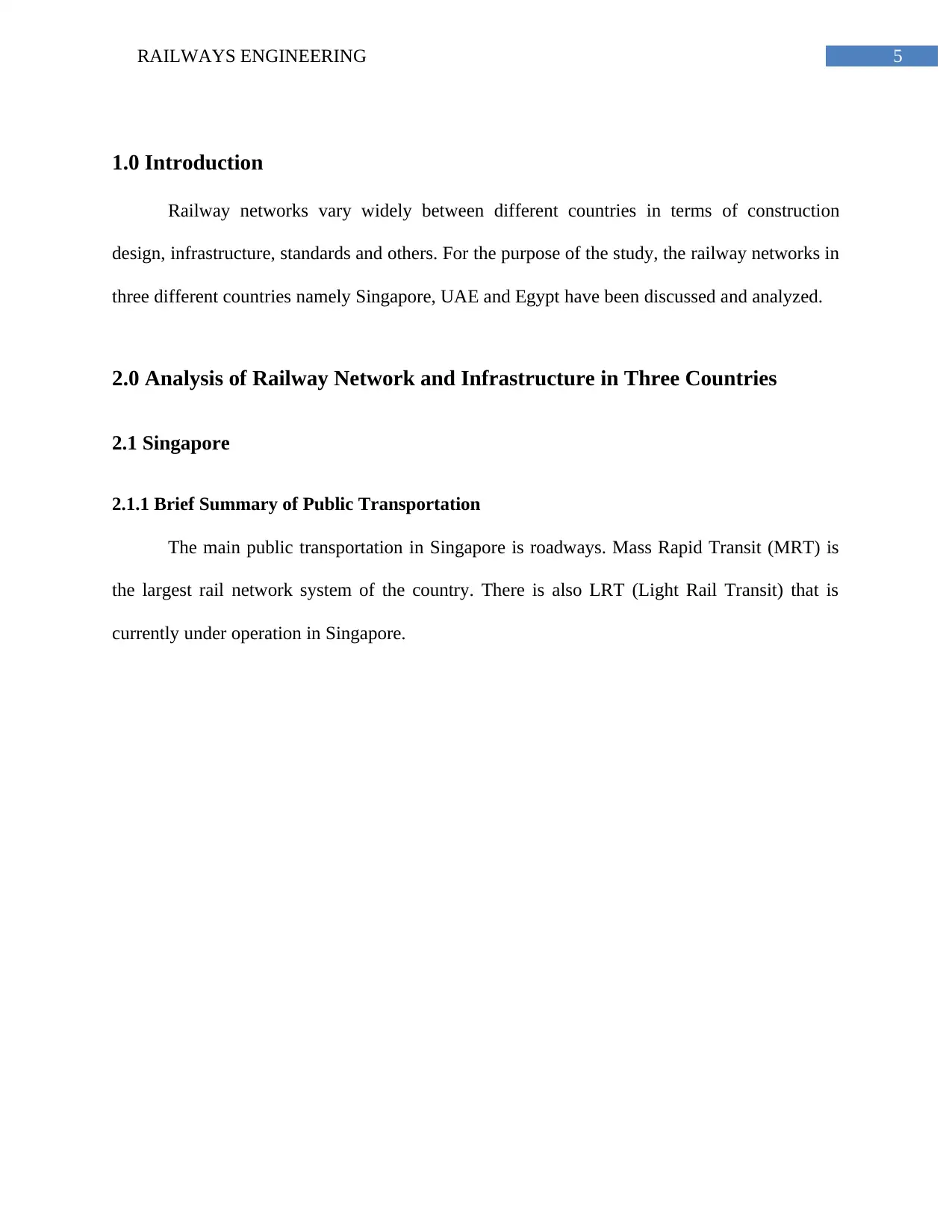
5RAILWAYS ENGINEERING
1.0 Introduction
Railway networks vary widely between different countries in terms of construction
design, infrastructure, standards and others. For the purpose of the study, the railway networks in
three different countries namely Singapore, UAE and Egypt have been discussed and analyzed.
2.0 Analysis of Railway Network and Infrastructure in Three Countries
2.1 Singapore
2.1.1 Brief Summary of Public Transportation
The main public transportation in Singapore is roadways. Mass Rapid Transit (MRT) is
the largest rail network system of the country. There is also LRT (Light Rail Transit) that is
currently under operation in Singapore.
1.0 Introduction
Railway networks vary widely between different countries in terms of construction
design, infrastructure, standards and others. For the purpose of the study, the railway networks in
three different countries namely Singapore, UAE and Egypt have been discussed and analyzed.
2.0 Analysis of Railway Network and Infrastructure in Three Countries
2.1 Singapore
2.1.1 Brief Summary of Public Transportation
The main public transportation in Singapore is roadways. Mass Rapid Transit (MRT) is
the largest rail network system of the country. There is also LRT (Light Rail Transit) that is
currently under operation in Singapore.
⊘ This is a preview!⊘
Do you want full access?
Subscribe today to unlock all pages.

Trusted by 1+ million students worldwide
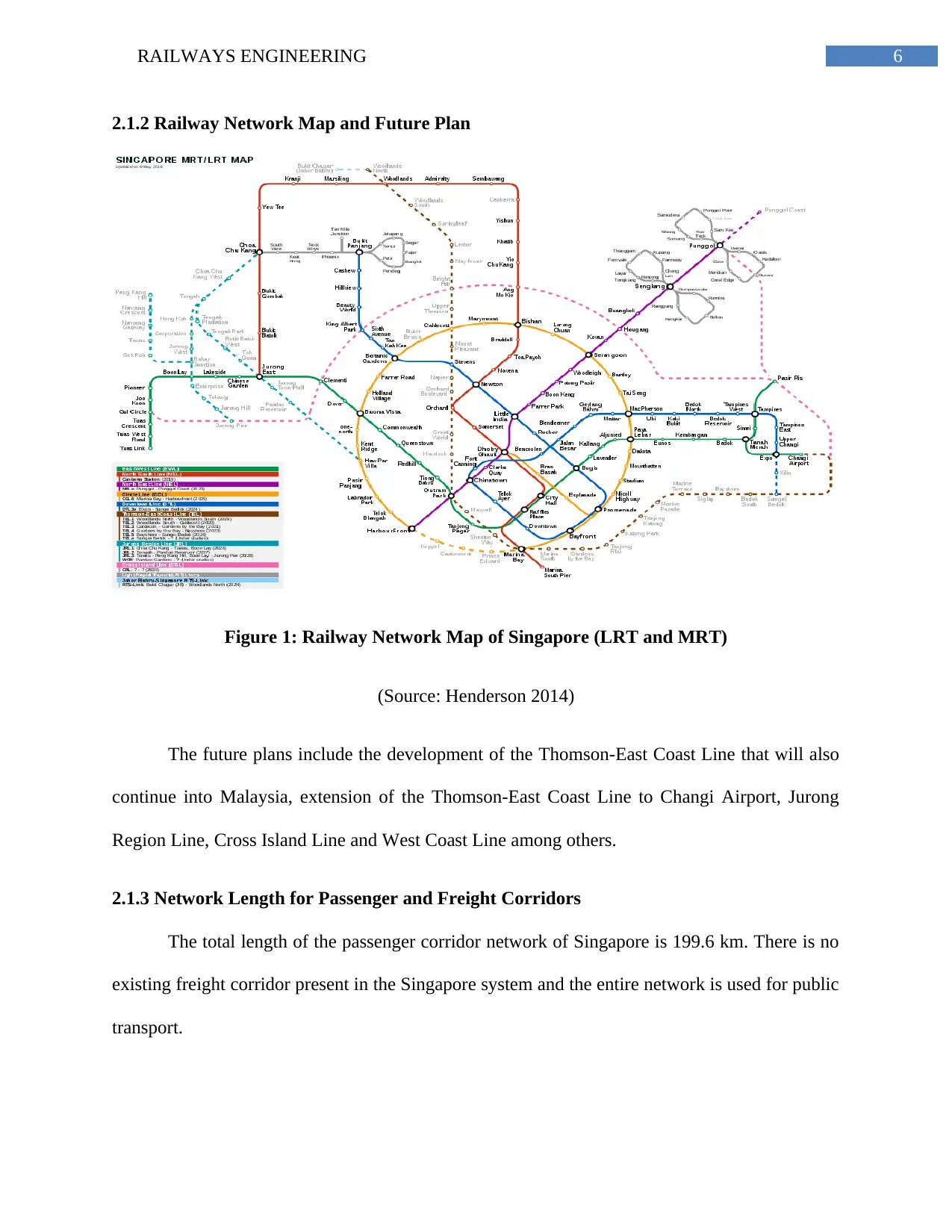
6RAILWAYS ENGINEERING
2.1.2 Railway Network Map and Future Plan
Figure 1: Railway Network Map of Singapore (LRT and MRT)
(Source: Henderson 2014)
The future plans include the development of the Thomson-East Coast Line that will also
continue into Malaysia, extension of the Thomson-East Coast Line to Changi Airport, Jurong
Region Line, Cross Island Line and West Coast Line among others.
2.1.3 Network Length for Passenger and Freight Corridors
The total length of the passenger corridor network of Singapore is 199.6 km. There is no
existing freight corridor present in the Singapore system and the entire network is used for public
transport.
2.1.2 Railway Network Map and Future Plan
Figure 1: Railway Network Map of Singapore (LRT and MRT)
(Source: Henderson 2014)
The future plans include the development of the Thomson-East Coast Line that will also
continue into Malaysia, extension of the Thomson-East Coast Line to Changi Airport, Jurong
Region Line, Cross Island Line and West Coast Line among others.
2.1.3 Network Length for Passenger and Freight Corridors
The total length of the passenger corridor network of Singapore is 199.6 km. There is no
existing freight corridor present in the Singapore system and the entire network is used for public
transport.
Paraphrase This Document
Need a fresh take? Get an instant paraphrase of this document with our AI Paraphraser
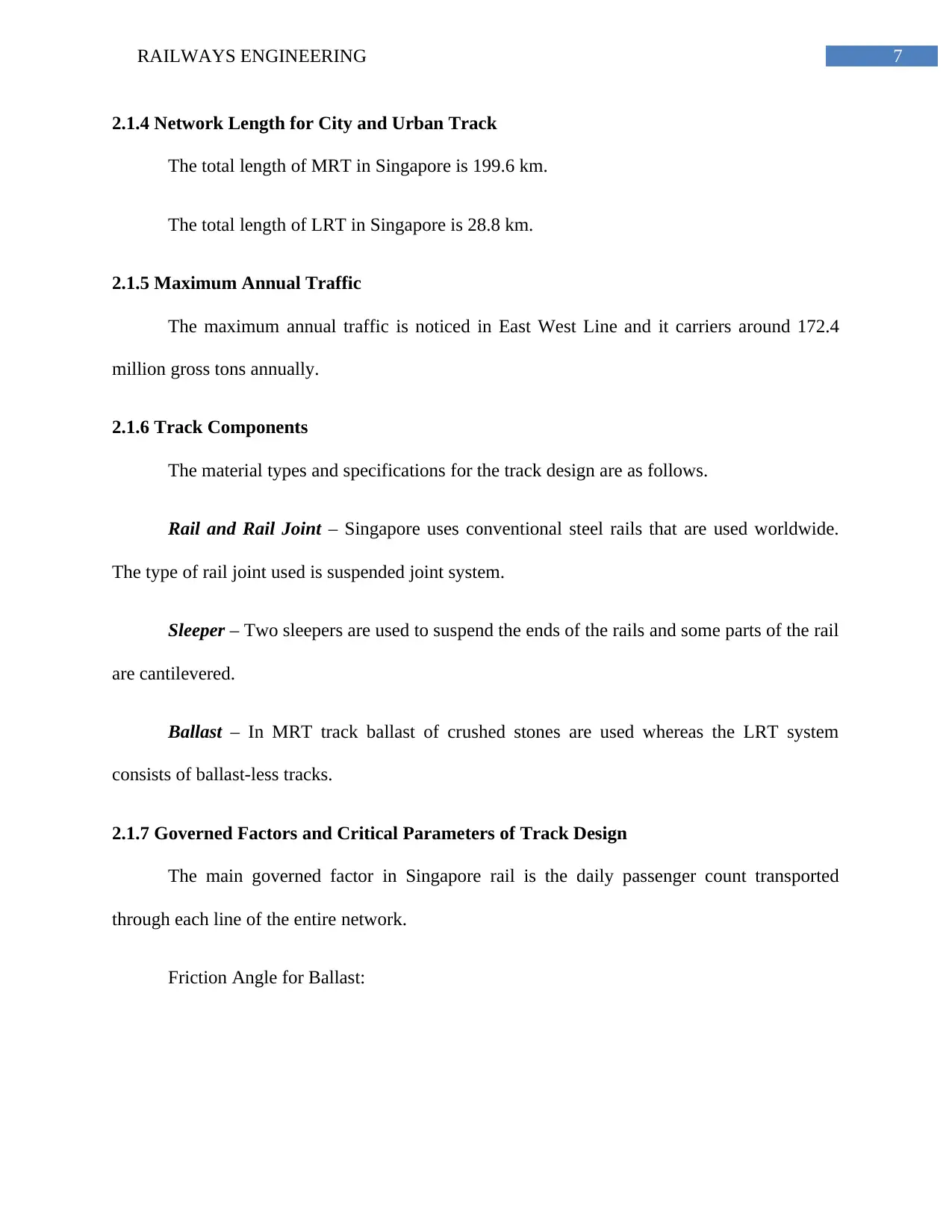
7RAILWAYS ENGINEERING
2.1.4 Network Length for City and Urban Track
The total length of MRT in Singapore is 199.6 km.
The total length of LRT in Singapore is 28.8 km.
2.1.5 Maximum Annual Traffic
The maximum annual traffic is noticed in East West Line and it carriers around 172.4
million gross tons annually.
2.1.6 Track Components
The material types and specifications for the track design are as follows.
Rail and Rail Joint – Singapore uses conventional steel rails that are used worldwide.
The type of rail joint used is suspended joint system.
Sleeper – Two sleepers are used to suspend the ends of the rails and some parts of the rail
are cantilevered.
Ballast – In MRT track ballast of crushed stones are used whereas the LRT system
consists of ballast-less tracks.
2.1.7 Governed Factors and Critical Parameters of Track Design
The main governed factor in Singapore rail is the daily passenger count transported
through each line of the entire network.
Friction Angle for Ballast:
2.1.4 Network Length for City and Urban Track
The total length of MRT in Singapore is 199.6 km.
The total length of LRT in Singapore is 28.8 km.
2.1.5 Maximum Annual Traffic
The maximum annual traffic is noticed in East West Line and it carriers around 172.4
million gross tons annually.
2.1.6 Track Components
The material types and specifications for the track design are as follows.
Rail and Rail Joint – Singapore uses conventional steel rails that are used worldwide.
The type of rail joint used is suspended joint system.
Sleeper – Two sleepers are used to suspend the ends of the rails and some parts of the rail
are cantilevered.
Ballast – In MRT track ballast of crushed stones are used whereas the LRT system
consists of ballast-less tracks.
2.1.7 Governed Factors and Critical Parameters of Track Design
The main governed factor in Singapore rail is the daily passenger count transported
through each line of the entire network.
Friction Angle for Ballast:
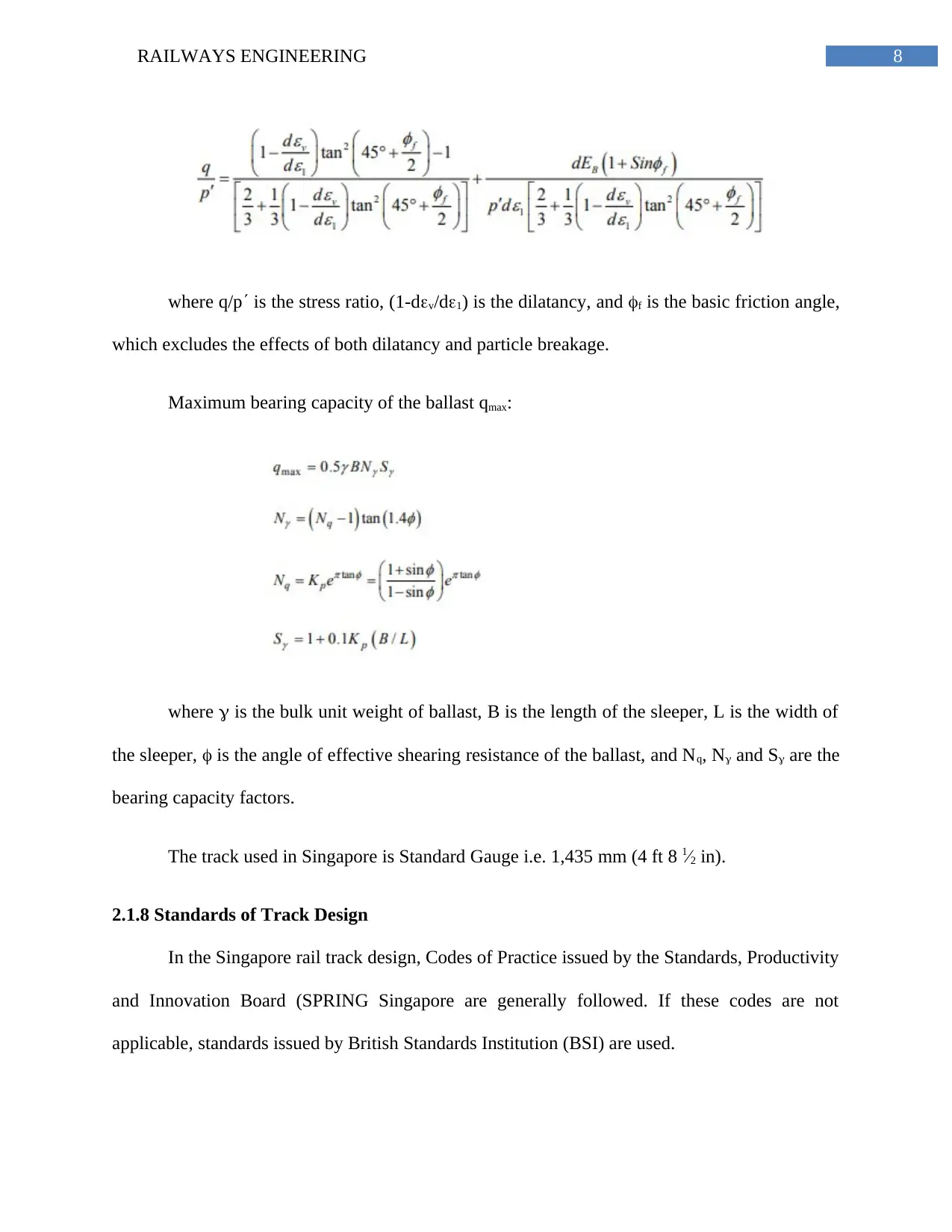
8RAILWAYS ENGINEERING
where q/p is the stress ratio, (1-dv/d1) is the dilatancy, and f is the basic friction angle,
which excludes the effects of both dilatancy and particle breakage.
Maximum bearing capacity of the ballast qmax:
where is the bulk unit weight of ballast, B is the length of the sleeper, L is the width of
the sleeper, is the angle of effective shearing resistance of the ballast, and Nq, N and S are the
bearing capacity factors.
The track used in Singapore is Standard Gauge i.e. 1,435 mm (4 ft 8 1⁄2 in).
2.1.8 Standards of Track Design
In the Singapore rail track design, Codes of Practice issued by the Standards, Productivity
and Innovation Board (SPRING Singapore are generally followed. If these codes are not
applicable, standards issued by British Standards Institution (BSI) are used.
where q/p is the stress ratio, (1-dv/d1) is the dilatancy, and f is the basic friction angle,
which excludes the effects of both dilatancy and particle breakage.
Maximum bearing capacity of the ballast qmax:
where is the bulk unit weight of ballast, B is the length of the sleeper, L is the width of
the sleeper, is the angle of effective shearing resistance of the ballast, and Nq, N and S are the
bearing capacity factors.
The track used in Singapore is Standard Gauge i.e. 1,435 mm (4 ft 8 1⁄2 in).
2.1.8 Standards of Track Design
In the Singapore rail track design, Codes of Practice issued by the Standards, Productivity
and Innovation Board (SPRING Singapore are generally followed. If these codes are not
applicable, standards issued by British Standards Institution (BSI) are used.
⊘ This is a preview!⊘
Do you want full access?
Subscribe today to unlock all pages.

Trusted by 1+ million students worldwide
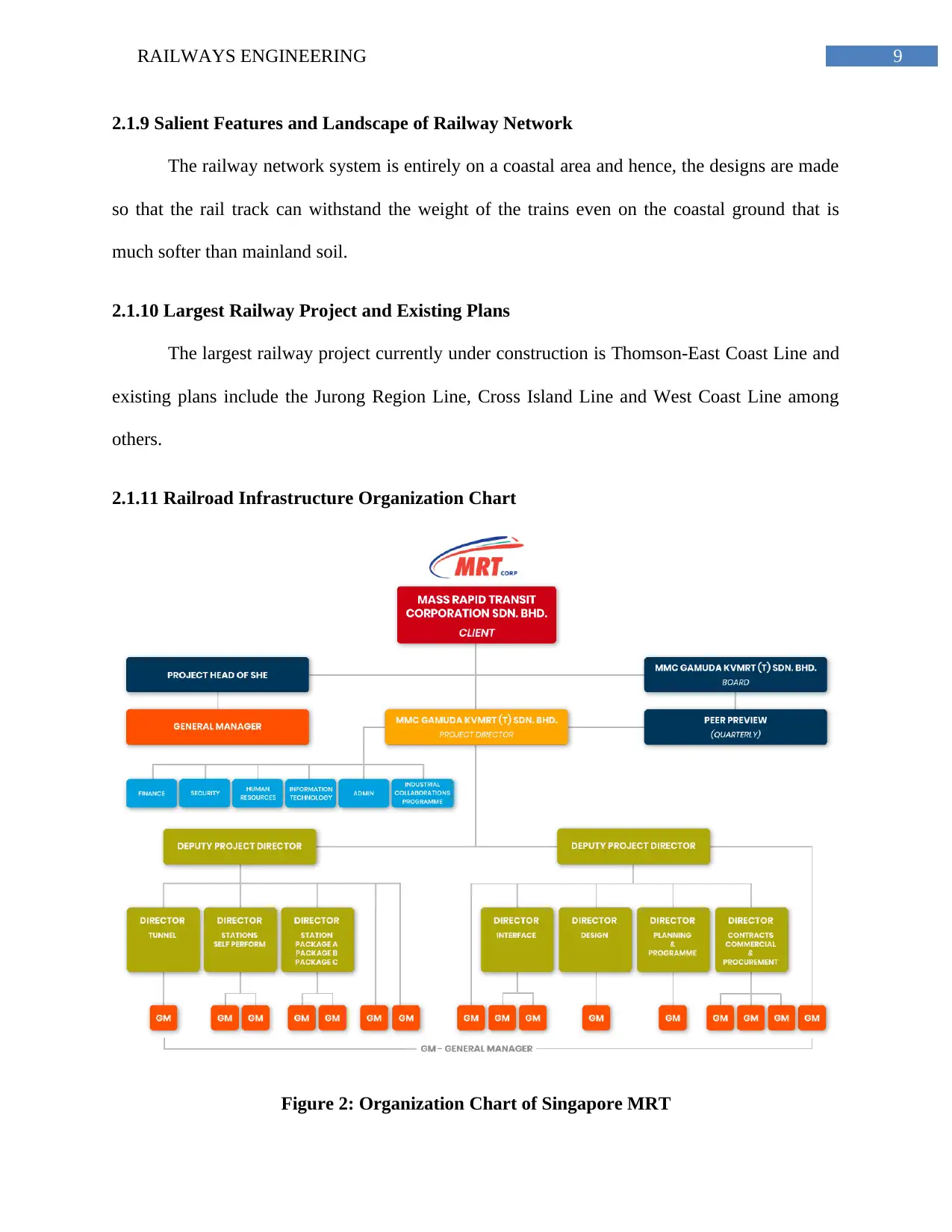
9RAILWAYS ENGINEERING
2.1.9 Salient Features and Landscape of Railway Network
The railway network system is entirely on a coastal area and hence, the designs are made
so that the rail track can withstand the weight of the trains even on the coastal ground that is
much softer than mainland soil.
2.1.10 Largest Railway Project and Existing Plans
The largest railway project currently under construction is Thomson-East Coast Line and
existing plans include the Jurong Region Line, Cross Island Line and West Coast Line among
others.
2.1.11 Railroad Infrastructure Organization Chart
Figure 2: Organization Chart of Singapore MRT
2.1.9 Salient Features and Landscape of Railway Network
The railway network system is entirely on a coastal area and hence, the designs are made
so that the rail track can withstand the weight of the trains even on the coastal ground that is
much softer than mainland soil.
2.1.10 Largest Railway Project and Existing Plans
The largest railway project currently under construction is Thomson-East Coast Line and
existing plans include the Jurong Region Line, Cross Island Line and West Coast Line among
others.
2.1.11 Railroad Infrastructure Organization Chart
Figure 2: Organization Chart of Singapore MRT
Paraphrase This Document
Need a fresh take? Get an instant paraphrase of this document with our AI Paraphraser
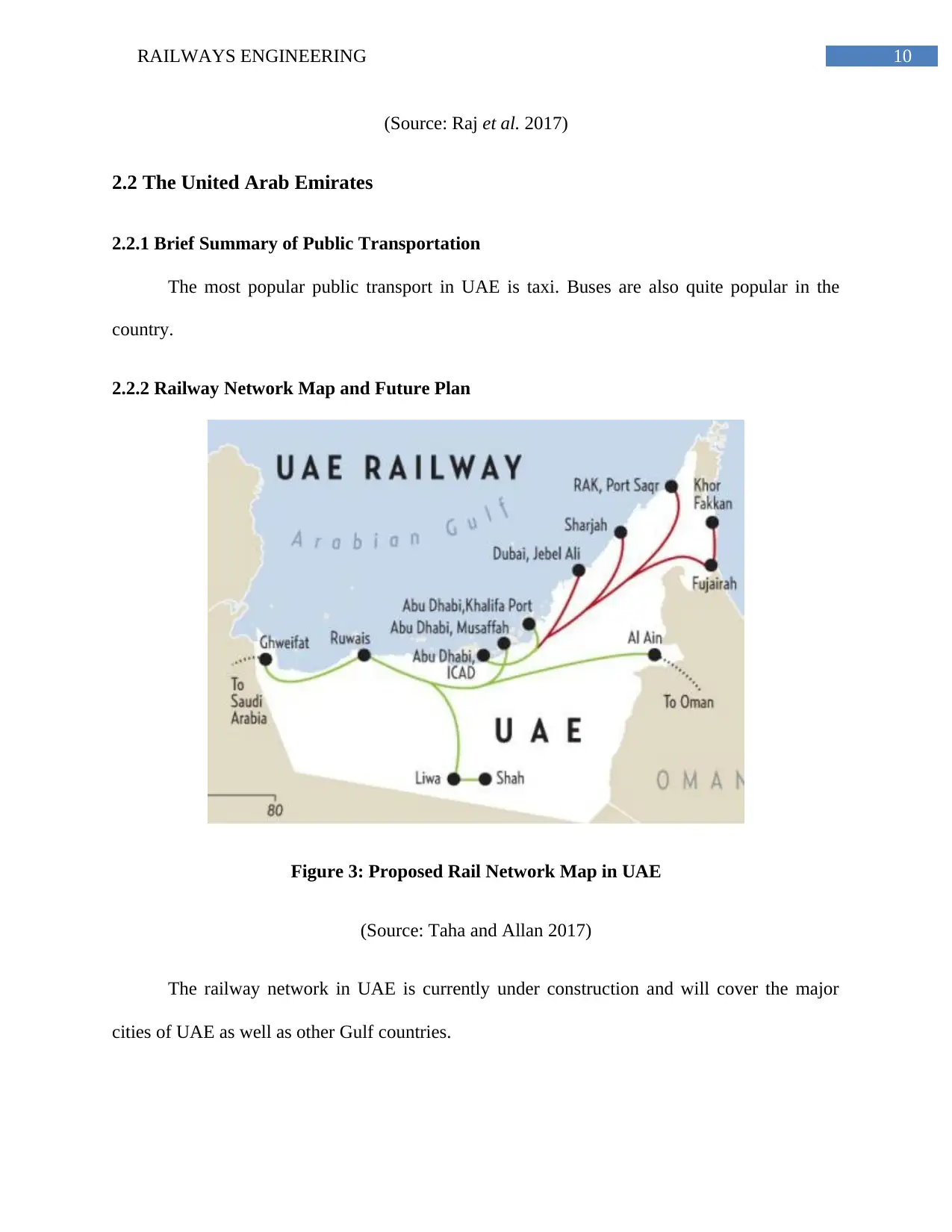
10RAILWAYS ENGINEERING
(Source: Raj et al. 2017)
2.2 The United Arab Emirates
2.2.1 Brief Summary of Public Transportation
The most popular public transport in UAE is taxi. Buses are also quite popular in the
country.
2.2.2 Railway Network Map and Future Plan
Figure 3: Proposed Rail Network Map in UAE
(Source: Taha and Allan 2017)
The railway network in UAE is currently under construction and will cover the major
cities of UAE as well as other Gulf countries.
(Source: Raj et al. 2017)
2.2 The United Arab Emirates
2.2.1 Brief Summary of Public Transportation
The most popular public transport in UAE is taxi. Buses are also quite popular in the
country.
2.2.2 Railway Network Map and Future Plan
Figure 3: Proposed Rail Network Map in UAE
(Source: Taha and Allan 2017)
The railway network in UAE is currently under construction and will cover the major
cities of UAE as well as other Gulf countries.
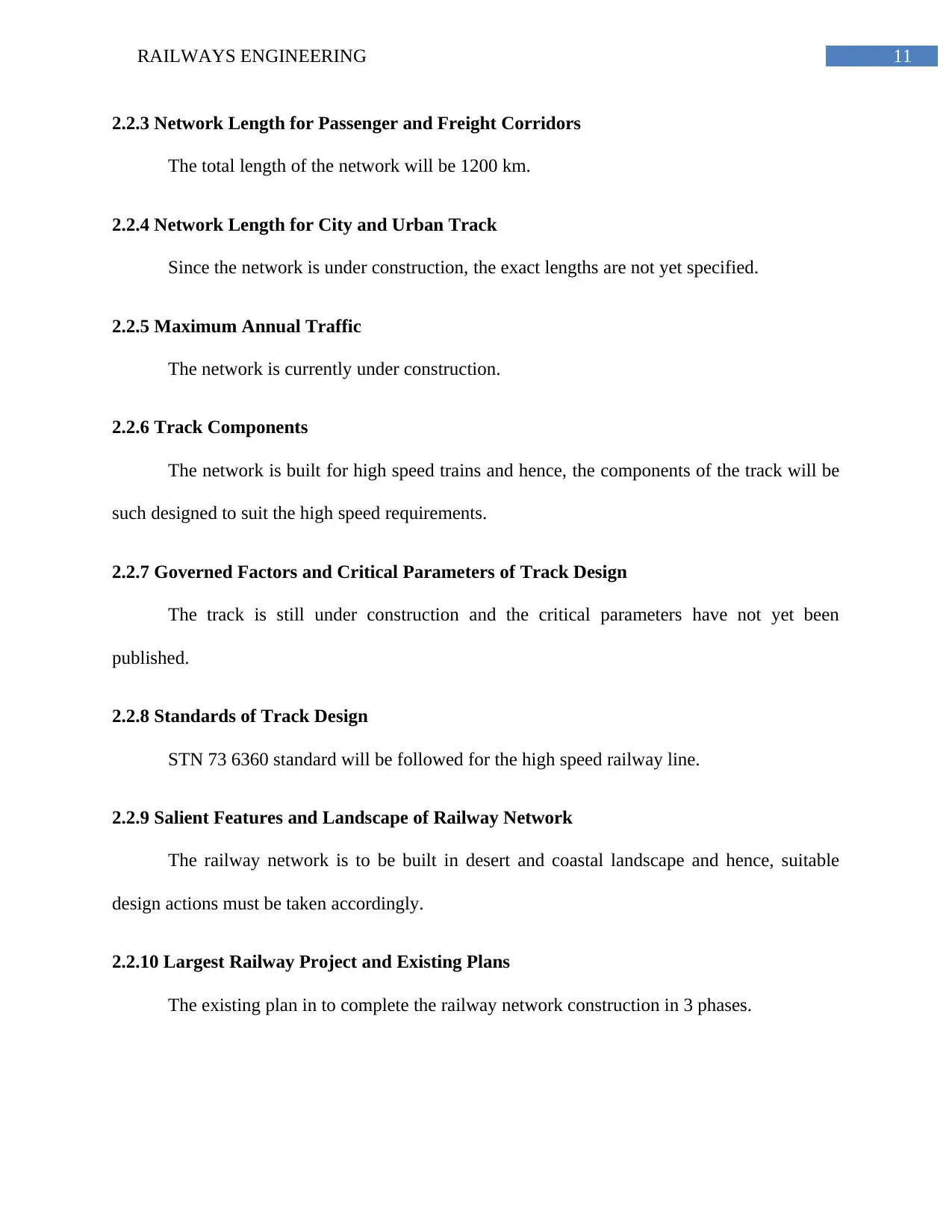
11RAILWAYS ENGINEERING
2.2.3 Network Length for Passenger and Freight Corridors
The total length of the network will be 1200 km.
2.2.4 Network Length for City and Urban Track
Since the network is under construction, the exact lengths are not yet specified.
2.2.5 Maximum Annual Traffic
The network is currently under construction.
2.2.6 Track Components
The network is built for high speed trains and hence, the components of the track will be
such designed to suit the high speed requirements.
2.2.7 Governed Factors and Critical Parameters of Track Design
The track is still under construction and the critical parameters have not yet been
published.
2.2.8 Standards of Track Design
STN 73 6360 standard will be followed for the high speed railway line.
2.2.9 Salient Features and Landscape of Railway Network
The railway network is to be built in desert and coastal landscape and hence, suitable
design actions must be taken accordingly.
2.2.10 Largest Railway Project and Existing Plans
The existing plan in to complete the railway network construction in 3 phases.
2.2.3 Network Length for Passenger and Freight Corridors
The total length of the network will be 1200 km.
2.2.4 Network Length for City and Urban Track
Since the network is under construction, the exact lengths are not yet specified.
2.2.5 Maximum Annual Traffic
The network is currently under construction.
2.2.6 Track Components
The network is built for high speed trains and hence, the components of the track will be
such designed to suit the high speed requirements.
2.2.7 Governed Factors and Critical Parameters of Track Design
The track is still under construction and the critical parameters have not yet been
published.
2.2.8 Standards of Track Design
STN 73 6360 standard will be followed for the high speed railway line.
2.2.9 Salient Features and Landscape of Railway Network
The railway network is to be built in desert and coastal landscape and hence, suitable
design actions must be taken accordingly.
2.2.10 Largest Railway Project and Existing Plans
The existing plan in to complete the railway network construction in 3 phases.
⊘ This is a preview!⊘
Do you want full access?
Subscribe today to unlock all pages.

Trusted by 1+ million students worldwide
1 out of 17
Related Documents
Your All-in-One AI-Powered Toolkit for Academic Success.
+13062052269
info@desklib.com
Available 24*7 on WhatsApp / Email
![[object Object]](/_next/static/media/star-bottom.7253800d.svg)
Unlock your academic potential
Copyright © 2020–2025 A2Z Services. All Rights Reserved. Developed and managed by ZUCOL.



